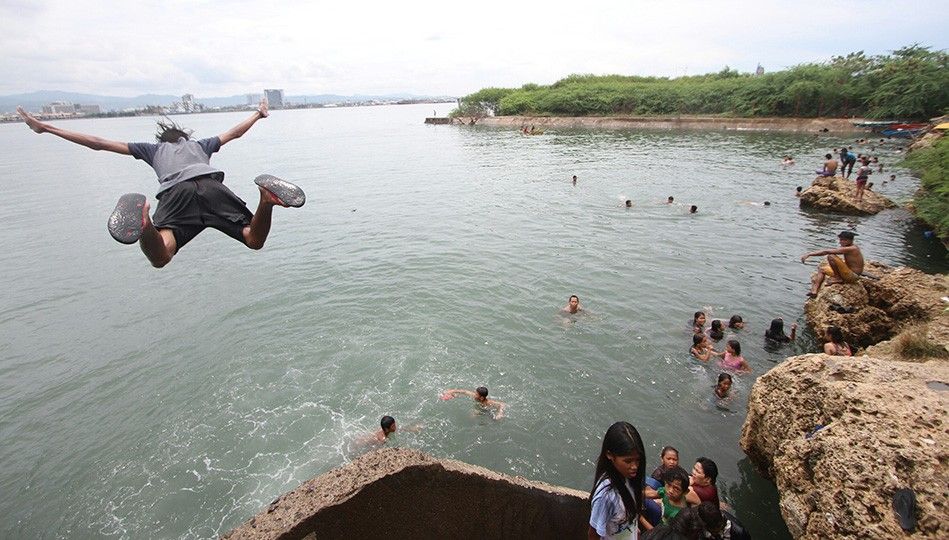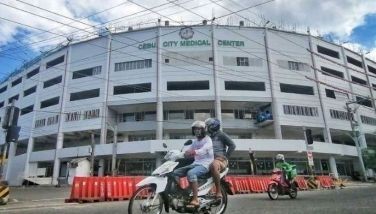High levels of coliform found: Mactan seas dirty

CEBU, Philippines — With temperature on the upswing, Lester Espinosa and his cousins headed off to the waters beneath the Marcelo Fernan Bridge yesterday to cool down.
In this part of the Mactan Channel, there was a repugnant smell in the air reminiscent of something greasy or rusty. In the shallow portions, the water was murky, and the seabed not visible to the eye.
“Maligo ra mi gud kay pampabugnaw,” the 18-year-old student told The FREEMAN. “Pero usahay naa lang maglutaw-lutaw nga tae, diapers, o patay nga iro (We often go here to cool ourselves down, but sometimes we would see human waste, used diapers, or dead dog floating).”
Espinosa’s group, like most other locals and visitors who go there to swim, did not seem to bother.
According to the Environmental Management Bureau-7, the seawaters off Mactan Island are contaminated with fecal coliform, a type of bacteria commonly found in human and animal feces.
EMB-7 Director Engr. William Cuñado said contaminants of fecal coliform in the seawaters surrounding the island, including the Mactan Channel which separates Mactan from mainland Cebu, were initially traced to direct human discharges from the slum areas.
EMB is an attached agency of the Department of Environment and Natural Resources responsible for monitoring water and air quality. It conducts monthly water quality testing from 10 sampling stations off Mactan.
In March, seawater samples collected showed an average of at least 200 most probable number (MPN) of fecal coliform per 100mL. The figure exceeds the national standard of 100 MPN per 100mL that has been set for water bodies intended for swimming.
Cuñado clarified that this figure is “not as significant” compared to those of other beaches in other regions whose coliform levels reach thousands.
But another study by the Lapu-Lapu City Environment and Natural Resources Office (CENRO) showed that in some areas, the level of contamination is extremely high.
A sampling done in the last week of March in the waters off the northern tip of the island, the contamination reached 1,600 MPN per 100mL. This is higher than the 1,045 MPN per 100mL registered off the coast of Tulubhan station on Boracay but lower than the 2,466 MPN per 100mL at Boracay’s Bulabog station.
CENRO pollution control officer Boy Padilla said the area where they collected the sample was off the coast of Arterra, which is part of Barangay Punta Engaño.
He clarified though that the area is currently being used more as a navigational route for boats rather than a bathing site. Swimming at the tip of the island is discouraged due to strong currents.
Punta Engaño is adjacent to other barangays of Lapu-Lapu City famous for their public and private beaches, including Mactan, Maribago, Subabasbas, Marigondon, and Agus.
Padilla said they were puzzled why the area showed an “alarming” level of fecal coliform because nearby residents and commercial establishments have established sewage treatment facilities (STF).
This led them to theorize that the source of pollution could be somewhere else.
“Nagtuo gyud mi nga ang rason nganong taas ang MPN kay tungod sa hugaw nga dala sa current,” he said.
Padilla said the water current carries both garbage and microbial waste from the towns of Liloan, Consolacion, and Mandaue City which are facing directly the northern part of Mactan from mainland Cebu.
He added that while it is true that wastes from residential houses also cause contamination, the major cause is the wastes carried by currents.
But EMB-7’s results said otherwise.
According to Cuñado, contaminants in the waters around the island were traced initially to the human waste discharges that are directly flushed into the waters.
Cuñado said there are several squatter areas on the island where households build makeshift toiletries along the shorelines.
He also said that even if samples were collected near one specific area that set up proper treatment or disposal facility, contaminated waters can still travel through the currents and be mixed to the clean waters.
CENRO is still waiting for the results of the tests on other water samples which they sent to two different water laboratories.
While waiting, Padilla said the city government continues to strengthen its efforts on environmental protection.
He said the city government gives away free toilet bowls to constituents, encourages the establishments to have septage tank if they have no STFs, and conducts inspections and monitoring.
The FREEMAN tried to reach Lapu-Lapu City Mayor Paz Radaza for her comment but was told that a press conference will be held today in light of the issue. —/JMD (FREEMAN)
- Latest





















